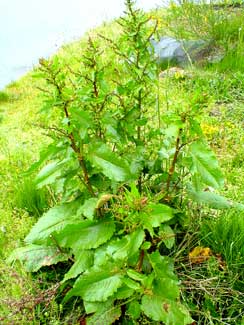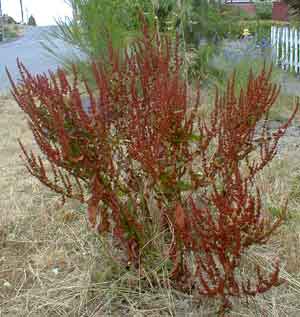
Western Dock; aka,
Giant Dock or Red Dock
"Weed --
a plant whose virtues have not yet been discovered."
-Ralph Waldo Emerson
(1803-1882)
(1803-1882)
When I posted some photos to a gardening newsgroup & said, "I need a name for this," one wit suggested Fred, so it has ever since been Fred.
There are many species of Rumex, & several that grow wild here in the Pacific Northwest. Some are introduced from Eurasia, especially Rumex crispus (Curly Dock) which is a cropland pest introduced into Australia & North America as seeds riding along in imported bales of alfalfa; R. obtusifolius (broadleaf curly dock) which has never become as pesky but is fairly common west of the Cascades; & others.
But Fred is our native perennial Western Dock, (R. occidentalis, synonymous with R. aquaticus var fenestratus), which is larger, sturdier & redder in summer, than are the invader species. It is native from Alaska to California, & throughout the western half of North America. It is common here in the Pacific Northwest.
 It is not only a proper native weed or wildflower, but it is not aggressive. It pops up in seasonally wet meadows a very few at a time, & is not weedy like Curly Dock. Though I have carefully mowed around this specimen on the grassy greenmargin of the street, & in three years it has gotten quite large, it has never spread elsewhere. It produces gazillions of seeds which can remain viable in the soil for three years, yet it just hasn't reproduced new plants anywhere nearby.
It is not only a proper native weed or wildflower, but it is not aggressive. It pops up in seasonally wet meadows a very few at a time, & is not weedy like Curly Dock. Though I have carefully mowed around this specimen on the grassy greenmargin of the street, & in three years it has gotten quite large, it has never spread elsewhere. It produces gazillions of seeds which can remain viable in the soil for three years, yet it just hasn't reproduced new plants anywhere nearby.I've encouraged this clump for a few years & it has gotten quite large. I was delighted to see it likewise encouraged in a nearby display garden of a park-like nursery, despite that it was not something they sell. So I'm definitely not the only one who considers this "weed" quite a pleasing garden plant.
This relative of buckwheat puts down a very deep taproot & gets larger each year. When its taproot is well developed, it is quite drought-hardy, but its ideal conditions are wet springs & dry summers, so it is most often seen on the edges of wetlands or seasonally flooded meadows, just so long as it can dry out in summer. It will remain green longest in a bog garden, but in our xeriscape garden where it gets plenty of rainfall in spring then pretty much no rain until autumn, it turns bright rust-red by July, the stems as well as the seeds being brightly colored. The large leaves along the stems drop off in summer leaving an almost extraterrestrial looking red plant.
The stems die back in autumn, sometimes sooner, but evergreen basal leaves, which freshened themselves with new growth about mid summer, last clear through winter into the following spring, sending up new flowering stems in spring. When cultivated as a garden specimen, it doesn't require any attention to thrive, but when the summer-reddened stems & seeds begin to look worn out, they can be trimmed out of the clump so that only the attractive large rosette of basal leaves remains for autumn & winter.
Native Americans, such as the Bella Coola of British Columbia, used Western Dock for treating rheumatism by steaming with it in a sweat lodge. Roots & leaves were roasted & mashed into a paste for topical use in treating wounds & sores.
The plant contains high levels of oxalic acid which give it a lemony flavor, potentially harmful if great amounts of it were eaten, but in general a safe food-plant. Too much of it too regularly could conceivably set the body up for calcium & other mineral deficiencies because oxalic acid interfers with the body's ability to process minerals, & might worsen such pre-existing conditions as arthritis or kidney stones.
Eaten occasionally, it is not harmful, & safer still when fully cooked so that the oxalic acid breaks down. Tender spring leaves can be used as a tart spinach, either fried in oil with dandylion leaves as a hot side-dish, or included in soups. Young stems can be used as a substitute for rhubarb, tasting similar to rhubarb. The seeds can be used as a substitute buckwheat, ground into flour for use in breads, mixed with other grains.